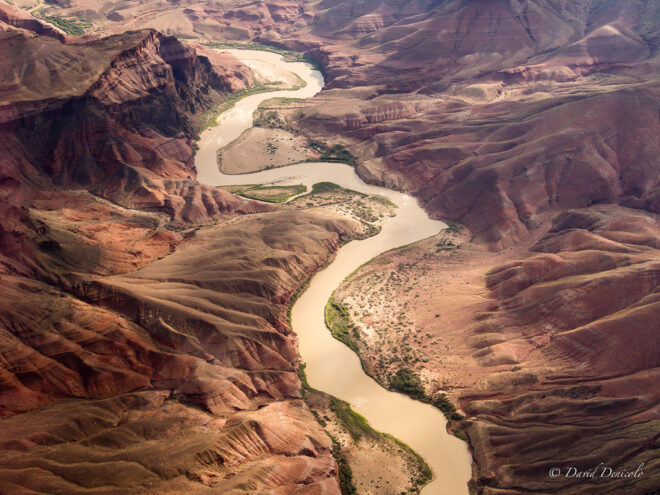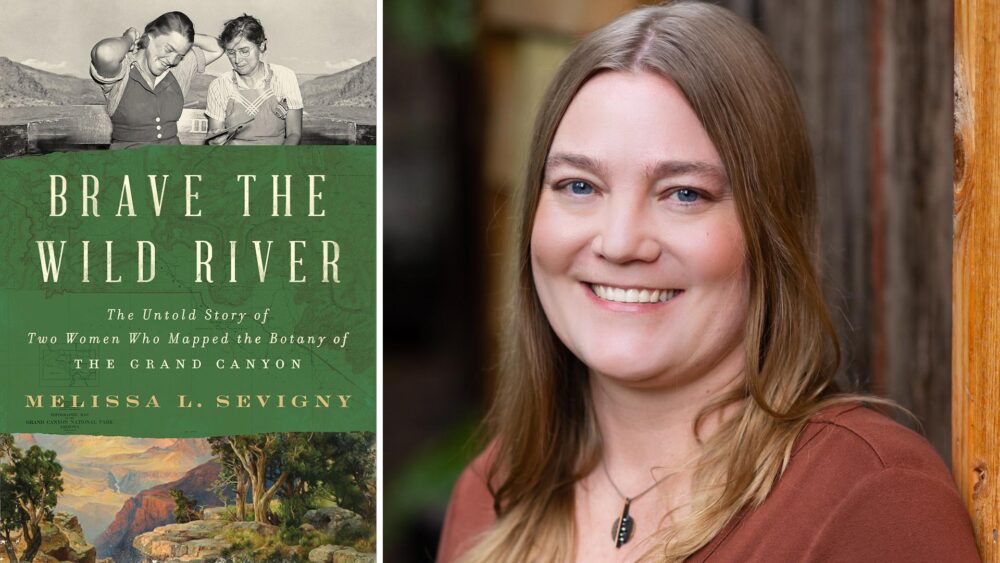Rosemary Purdie reviews Brave the Wild River: The Untold Story of Two Women Who Mapped the Botany of the Grand Canyon, by Melissa L Sevigny, published by W W Norton & Company, 2023
‘In the summer of 1938, botanists Elzada Clover and Lois Jotter set off to run the Colorado River, accompanied by an ambitious and entrepreneurial expedition leader, a zoologist, and two amateur boatmen.’ So goes the publisher’s blurb…tantalising my imagination with thoughts of collecting plants along a river renowned for its rapids, wondering why a zoologist was there and curious about the compatibility of scientists and ambitious entrepreneurs. My imagination could never have come up with the true story that is the subject of this book.
Clover, one of nine children brought up on a farm in Nebraska, USA, in 1930 (aged 34) enrolled at the University of Michigan for postgraduate studies in botany. After defending her PhD in 1935, she joined the University’s Botany Department, the only female on the staff. At a time when male expectations of a female botanist were for them to be ‘attractive, mannerly, a good teacher’, the glove didn’t exactly fit. Clover was ‘active, robust…daring,…drank whiskey…could swim, fish, hunt, and ride a horse’ and ‘her research speciality, cacti, were the least demure plants imaginable’. Her dream was to make a field study of all the cacti in the Southwest, ideally collecting plants from places inaccessible to cars.
Clover’s dream became a possibility in August 1937. On a collecting trip in Utah, she met Norman Nevills, a 29-year-old tourist guide who dreamt of rafting the Colorado River through the Grand Canyon, an area Clover knew no botanist had ever explored from head to foot. Their chance meeting led to the 1938 expedition that would map the botany, not just of the Grand Canyon, but along 600 miles (1000 km) from their starting point on the Green River to its confluence with the Colorado, through the Grand Canyon to their end point near the newly constructed Boulder Dam.
In the 10 months before the start of the journey, Nevills designed and hand-built three wooden boats, recruited two oarsmen to help row/steer them, and left Clover to select two more scientists to complete the team. She chose 24-year-old Jotter, a young friend and university colleague, as a second botanist, and 25-year old zoologist Eugene Atkinson who planned to collect and sell animals skins (and whom Nevills wanted only as a backup oarsman).
Brave the Wild River’s author – science journalist Melissa Sevigny – describes the 43-day expedition in detail, drawing heavily on the diaries and letters of its participants to bring the journey alive. This includes the complicated logistics of making the trip happen, the nature of the ever-changing river and surrounding environments, the physical and mental challenges the river threw at them, and the interactions of six very different personalities whose only common point was rafting the river.

The physicality of the journey makes for riveting reading. Often described as ‘the most dangerous river in the world’ the Colorado was ‘governed by the mad rhythms of a desert climate’ that each spring saw ‘surges of snowmelt, thick with mud … followed by torrents of storm water in summer’. The relatively high level of the river during much of the expedition meant the team had to contend with dangerous rapids, white-water waves, unpredictable eddies and currents. In places the river was ‘chewing up whole trees and spitting them out like toothpicks’, while long sections were a nearly continuous stretch of turbulent water. Each set of rapids required expedition leader Nevills to decide whether they would raft them, or guide the boats along the edge of the river, while the team members picked their way along the shore, or physically drag the boats and portage their contents across land to the next section of raftable water. Blisters on hands and feet, cuts and bruises became to norm, as did being constantly soaked.
During the journey, Clover and Jotter aimed to document the flora of the Colorado River, and ‘bring out a trove of pressed plants for scientific research’ that would also become ‘an essential record of a region that was changing fast’. They botanised at every opportunity, cataloguing the species they saw, collecting specimens when they were able to. The daily routine of ‘wake early, make breakfast, press plants, run rapids, cook dinner, sleep, repeat’ masks the daily challenges on the river and the amount of time they spent on their scientific work, filling notebooks with observations and detailed descriptions of the plants. Such information allowed them to examine the extent to which the Colorado’s flora fitted with scientific theories relating to the natural distribution of plants, like ecological succession, natural selection, and North American biotic ‘life zones’.
The river’s history
As the story of the expedition’s journey unfolds, the author interweaves it with other tales that give enriching contextual information. The history of white exploration of the river shows only a small number of people who rafted the Colorado successfully; more either died trying or abandoned their attempt. This dovetails with sections outlining the prevailing attitudes Clover and Jotter had to contend with, especially in the lead up to, and during the expedition: that females were unsuited for exploration, that the Colorado is ‘no place for women’, and that the women would be a liability on such as trip. The media frenzy that accompanied the expedition was built on such themes, despite Clover’s attempts to focus reporting on the scientific work.
As chapter by chapter the team progresses down river, we learn about the geological history of its gorges and canyons, of the Indigenous peoples for whom the river had been part of their home lands for three to four thousand years, of the people who came later – white fur trappers, Mormons, gold seekers with dredges, surveyors recording data for the best places to locate dams and engineers dreaming of constructing them, of lodge owners and tourist operators. We get exposed to water and land management issues in the Colorado basin and beyond that have eerie similarities with those in Australia’s Murray Darling Basin – dam building, arguments over water access, overallocation of water for irrigation coupled with unrealistic expectations about the amount of water available. We learn about the national parks and monuments along the Colorado, how their management at the time ignored the area’s Indigenous groups and their cultural values, and was more about providing opportunities for tourism than conserving the flora and fauna.
After the successful completion of the river journey, the book’s focus shifts – to how the expedition changed attitudes towards rafting the Colorado by both men and women, how the construction of dams changed the river environment and increased tourism activity on it, and how increasing scientific knowledge and changing community attitudes eventually led to the need for environmental impacts to be assessed prior to the commencement of major developments.
After the expedition
We also learn of the post-trip lives of Clover, Jotter, Nevills and others whose lives were intertwined with them. Clover and Jotter published scientific papers on the cacti and general floristics of the Colorado and its tributaries, providing a benchmark for subsequent research there on the floristic effects of dams. Clover remained at the University of Michigan, became Curator of their Botanical Gardens in 1957, Professor of Botany in 1960 (the first woman to do so) and Professor Emerita of Botany on her retirement in 1967. Cacti, the Colorado and deserts remained part of her life until she died in 1980.
Jotter completed her PhD at the University of Michigan, married part way through it and shifted with her scientist husband to universities in New York and later North Carolina. After three children and the loss of her husband to cancer, she took up a position as assistant professor of biology at the University of North Carolina where she became a teacher and mentor to students while continuing her scientific research. Aged 80, she returned to the Grand Canyon on a 12-day rafting trip with a group of 12 other experts to study ecological changes resulting from the Glen Canyon Dam. For her too, the Colorado remained a strong part of her life until she died in 2013.
As a professional field botanist, I was captivated by the story of Clover and Jotter; it is an inspiration for anyone aspiring, against the odds, to be a field scientist. But this well-researched book is also a story about a river, its geology, ecology, human occupation, and history of competing and often conflicting uses, and deserves a much wider readership.
Brave the Wild River was the winner of the 2023 National Outdoor Book Award for History/Biography.


